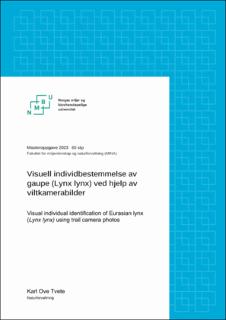| dc.contributor.advisor | Richard Bischof | |
| dc.contributor.advisor | Neri Horntvedt Thorsen | |
| dc.contributor.author | Tvete, Karl Ove | |
| dc.date.accessioned | 2023-07-13T16:27:59Z | |
| dc.date.available | 2023-07-13T16:27:59Z | |
| dc.date.issued | 2023 | |
| dc.identifier | no.nmbu:wiseflow:6839647:54592822 | |
| dc.identifier.uri | https://hdl.handle.net/11250/3078686 | |
| dc.description.abstract | Bestandsestimering av store rovdyr er vanskelig, ettersom store rovdyr er skye dyr med store leveområder. Det brukes flere ulike metoder for å estimere bestandene av store rovdyr, som DNA-innsamling, sporing på snø og viltkamera-overvåkning. Bilder fra viltkamera benyttes også til individbestemmelse for enkelte arter. Dette forutsetter at arten har permanente markører som er unike for hvert individ, ikke endrer seg igjennom dyrets levetid og er synlige på viltkamerabilder. Denne metodikken benyttes ofte til å estimere bestander av mønstrete kattedyr, for eksempel gaupe (Lynx lynx). Forskere individbestemmer fotograferte gauper ut ifra pelsmønster og estimerer bestand og tetthet ut ifra antall individbestemte dyr.
Denne studien undersøker nøyaktigheten av individbestemmelse av gauper fotografert med viltkamera. Dette ble testet med viltkamerabilder av 40 kjente gauper fra 13 dyreparker i Norge, Sverige, Danmark, Finland, Tyskland og England. Bilder av de ulike individene ble sammenliknet i en nettbasert undersøkelse hvor deltakerne skulle avgjøre om to gaupe-observasjoner var av samme individ, av ulike individer eller uidentifiserbare.
Resultatene fra undersøkelsen viste at sammenlikninger med minst en uniform gaupe hadde høyest sannsynlighet for å bli regnet som uidentifiserbare. Deltakerne mente at nesten halvparten av alle sammenlikninger med to uniforme gauper var uidentifiserbare. Sammenlikninger med minst en IR-natt-observasjon hadde signifikant høyere sannsynlighet for å være uidentifiserbare enn sammenlikninger med to dag-observasjoner. Deltakers erfaring så derimot ikke ut til å påvirke sannsynligheten for å besvare en sammenlikning. Deltakere med erfaring fra visuell individgjenkjenning av gaupe har derimot høy sannsynlighet for å svare rett >95%. Sammenlikninger med to uniforme gauper viste signifikant høyere sannsynlighet for å bli feilidentifisert enn sammenlikninger med minst en mønstret gaupe. To IR-natt-observasjoner viste også en tendens til å gi høyere sannsynlighet for feil svar sammenliknet med to dag-observasjoner. Selv om andelen feil var lav, kan feilene gi store utslag ved en reell bestandsestimering. Feil som innebærer at deltakeren svarer at to observasjoner av samme individ er to ulike individer skaper ikke-eksisterende «spøkelses-individer». Dette kan derfor føre til store overestimat av en bestand. Metodikken bør fungere til å skille familiegrupper, eller til å estimere bestander med lav andel uniforme gauper. Dette forutsetter at individbestemmelsen blir utført av to eller flere erfarne personer. | |
| dc.description.abstract | To estimate the population of large carnivores is difficult. Large carnivores are elusive animals with large home-ranges. Several different methods are used to estimate the populations of large carnivores, including collection of DNA samples, tracking in snow, and trail camera monitoring. Photos from trail cameras are used for individual identification of some species. This method works if the species has permanent markers that are individually unique and do not change throughout the animal's lifetime and that the markers are visible on trail camera photos. This method is used to estimate the population of patterned felids, like lynx (Lynx lynx). Researchers identify photographed lynx individuals based on their fur pattern, and estimate population and density based on the number of identified animals.
This study examines the accuracy of individual identification of lynx photographed with trail cameras. The study used trail camera photos of 40 lynx from 13 zoos in Norway, Sweden, Denmark, Finland, Germany, and England. Photos of the different individuals were then compared in an online survey where participants were asked whether there were two observations of the same lynx, two different lynxes, or if the observations were unidentifiable.
The results of the survey showed that comparisons with at least one uniform lynx had the highest likelihood of being considered unidentifiable. Participants thought that almost half of all comparisons with two uniform lynxes were unidentifiable. Comparisons with at least one IR-night observation had a significantly higher likelihood of being unidentifiable than comparisons with two daytime observations. However, participants experience did not seem to affect the likelihood of answering a comparison. However, participants with experience in visual lynx identification, had a high likelihood of answering correctly (>95%). Comparisons with two uniform lynxes showed a significantly higher likelihood of being misidentified than comparisons with at least one patterned lynx. Two IR-night observations also showed a tendency to give a higher likelihood of incorrect answers compared to two daytime observations. Although the proportion of errors was low, errors that result in the participant answering that two observations of the same individual are two different individuals create non-existent “ghost individuals." This can therefore lead to overestimation of a population. The methodology should work to distinguish family groups or estimate populations with a low proportion of uniform lynx. This assumes that individual identification is performed by two or more experienced persons. | |
| dc.language | nob | |
| dc.publisher | Norwegian University of Life Sciences | |
| dc.title | Visuell individbestemmelse av gaupe (Lynx lynx) ved hjelp av viltkamerabilder | |
| dc.type | Master thesis | |
